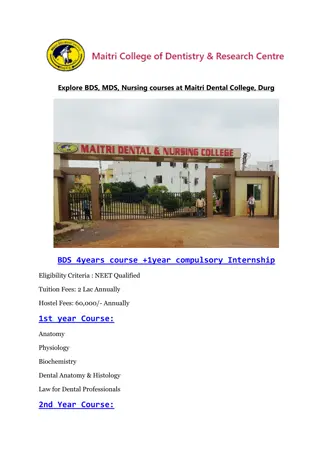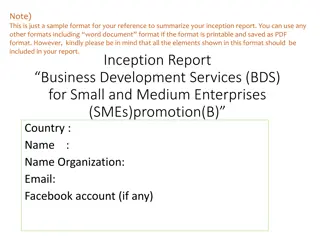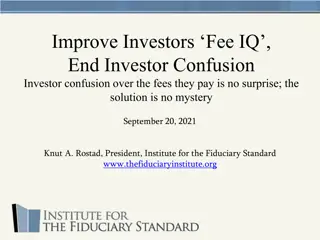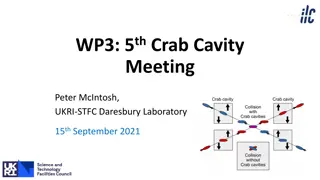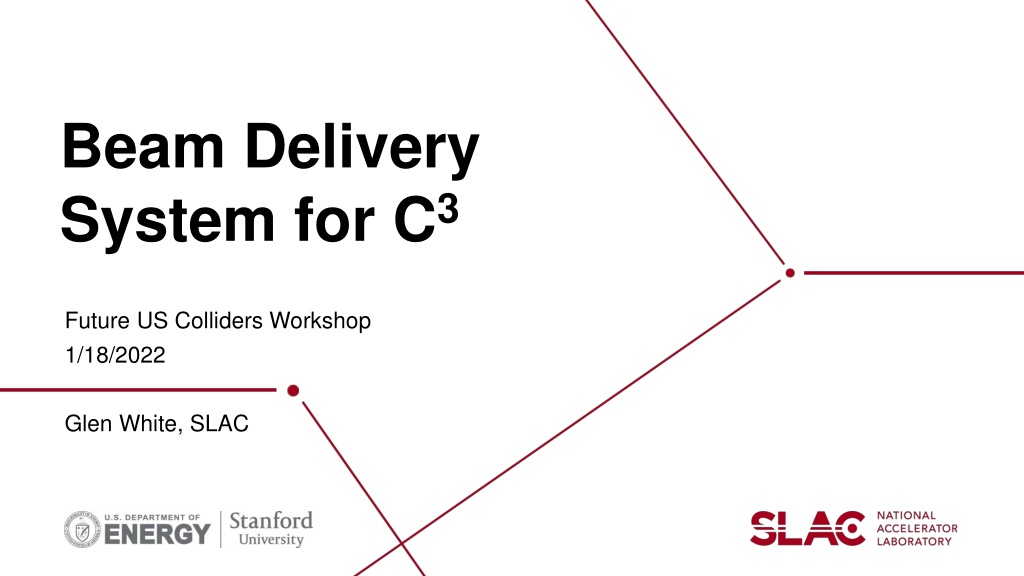
Advanced Beam Delivery Systems for Future Colliders
Explore the intricate details of Beam Delivery Systems for future C3 colliders, comparing the ILC and CLIC designs with a focus on design tradeoffs, tolerance considerations, and energy scaling. Gain insights into the mature ILC BDS design and the more aggressive CLIC BDS design, highlighting the tightening of tolerances and beam tuning aspects. Discover the considerations and requirements for C3 colliders, paving the way for advanced collider technologies.
Download Presentation

Please find below an Image/Link to download the presentation.
The content on the website is provided AS IS for your information and personal use only. It may not be sold, licensed, or shared on other websites without obtaining consent from the author. If you encounter any issues during the download, it is possible that the publisher has removed the file from their server.
You are allowed to download the files provided on this website for personal or commercial use, subject to the condition that they are used lawfully. All files are the property of their respective owners.
The content on the website is provided AS IS for your information and personal use only. It may not be sold, licensed, or shared on other websites without obtaining consent from the author.
E N D
Presentation Transcript
Beam Delivery System for C3 Future US Colliders Workshop 1/18/2022 Glen White, SLAC
Overview Review of BDS subsystems Review of existing designs: ILC & CLIC Discussion of design tradeoffs Example tolerance tradeoffs ILC vs. CLIC Compact Higgs-factory C3 layout design Discussion of options/requirements for C3 550 GeV collider considerations Energy scaling Consider R&D topics / demo facility 2
ILC BDS (TDR, 2013) Ecm 250 1,000 GeV 500 GeV Parameters Layout for 1 TeV, decimate magnets for operation at 500 GeV 1.8 x 1034 L (cm-2s-1) 10 / 0.035 x / y (um.rad) x* / y* (mm) z* (mm) x* / y* (nm) N 11 / 0.48 0.3 474 / 5.9 2 x 1010 1312 NB frep / Hz Pbeam (MW) Length (m) 5 5.3 2254 ILC BDS Design is very mature, result of decades of work, includes many engineering (detector implementation) considerations, errs on the side of low-risk, motivated from experience @ SLC 3
CLIC (PIP) Ecm = 380 GeV & 3 TeV 380 GeV Parameters CLIC BDS design considerably more aggressive 4X tighter focusing, L* = 6m vs. 4.1m for ILC ( y increased 7X) Tighter alignment tolerances & more complex tuning Shown to work in theory through start-to-end sims FFS operation at increased chromaticity not yet proven experimentally (ATF2) CLIC is a more compact & aggressive design with corresponding increases in risk 4
Tightening of Tolerances CLIC 10 um ILC CLIC design requires order-of-magnitude increased precision for alignment & measurements Collimation: 100X lower halo population assumed 10-5 vs 10-3 Active magnet stabilization required 1 nm 20 nm Pushed design manifests as tightened tolerances, riskier operating assumptions 5
Beam tuning: ILC & CLIC CLIC (3 TeV) ILC (500 GeV) t < 1 hour https://agenda.linearcollider.org/event/2364/contributions/6540/attach ments/4889/8239/ILC-LET2007.pdf Higher chromaticity design takes longer to tune Requires more non-linear tuning devices (Octupoles+) E. Marin et al 2018 J. Phys. : Conf. Ser. 1067 022014 Pushed BDS design requires more complicated, longer tuning process 6
C3 BDS @ Ecm = 275 GeV 137.5 GeV 1245.6 m 12 x 0.12 mm 4.3 m 7 mrad 10,000 / 20 nm-rad 1E-4 6.25E9 133 20 100 um rms 120 Hz Max Beam Energy Length (S) IP Beta L* * x / y dE/E N Nb crossing angle bunch length rep rate machine Re-design for short footprint Start with ILC2016X lattice Use NLC FFS design Remove bend gaps and scale bends for 137.5 GeV Remove u/s polarimeter Re-matched Options for further reduction? Stronger lattice ($ opt) Merge systems (e.g. COLL & Diag.) Design challenge for C3: reduce length footprint 7
Options/Requirements for C3 @ 550 GeV Achievable path length? 1250-2000 m per side Work required to assess length/cost/risk tradeoffs Implementation plan Take CLIC approach, build 275 GeV with tunnel space to build 550 GeV option later if want to start with min site footprint Decimate magnets like ILC if want ease of upgradability and stability in central region site design Requirements: Emittance: min = CLIC ~ 1 x 0.02-0.03 um-rad - Photo-cathode @ 0.1 x 0.1 um-rad? Energy stability / bandwidth - Collimation system designed to handle up to 1 (1.3) % off-energy bunch for ILC (CLIC) - Bandwidth for luminosity < +/- 0.5% Energy bandwidth simulation & measurement for ATF2 y ~ ILC y ~ CLIC R. Yang et. al., Phys. Rev. AB,"24", 51001 (2021) 8
Collider Considerations (Round Beam) Final Focus Parameter Value E *x,y x,y E/E L* (Q0 exit to e- IP) *x,y *x magnet aperture 106 2.5 0.14 62.8 GeV 0.03 mm 120 nm-rad 0.05 % 3.5 m 5.4 nm 20 mrad 2 cm diameter x [m] y [m] x [m] 0.12 2 0.1 0.08 1.5 0.06 1 0.04 0.02 0.5 0 0 -0.02 176 177 178 179 180 181 182 183 184 185 S [m] Following Raimondi-Seryi recipe for FFS design, shown possible to construct optics with correct properties for round beams @ IP Further considerations: Full tuning, S2E sims etc needed to assess tunability, tolerances, bandwidth etc + BDS integration Required IP focusing 3X increased beyond CLIC Integration with source (gamma-focusing optics) Additional beams for IP deflection (beamstrahlung mitigation) Re-assess straight-ahead beam collisions Collider requires round-beam FFS optics with small * (novel design required). Also interesting to consider for C3 with photocathode source. 9
R&D / Demonstrator Requirements etc Resurrect S2E simulation capability to be able to assess design options Application of modern ML/AI optimizers applied to tuning Can increase confidence in pushed designs, reduce tuning time Applied to luminosity monitoring system for online reconstruction of beam aberrations at IP: also helps with tuning accuracy and speed Round-beam, small focus Optics designs & simulations reliable (FFTB & ATF2 worked) - Always value added in test facilities, but obviously costly and time intensive FACET-II operates with round-beams (E=10 GeV, *>5cm, z<1um, Q<2 nC) - Low-charge (<100pC), strong focusing demo here? (needs photo-cathode source & Sector 20 lattice upgrades at least) collider: design with light optics & deflection scheme integration If want to push y beyond ILC levels, demo of ability to manufacture and operate systems with increased stability requirements desirable ATF2 still operates with reduced schedule but needs serious investment to continue or expand 10
BDS Length Scaling with Beam Energy CLIC ILC ILC Ecm = 1 TeV 826 562 866 2254 CLIC Ecm = 3 TeV 446 1250 1054 2750 => L ~ E7/10 (Original Raimondi/Seryi paper) FFS Bending Sections Other Total (ISR) => L ~ E2 ( for fixed peak Dispersion) L ~ E An (entirely wrong) estimate of BDS length scaling with energy based on either ILC or CLIC baseline designs (Lumi ~ E) 11
Summary Mature designs exist for BDS systems Ebeam 125 GeV 1.5 TeV (ILC & CLIC) Significant effort in simulations & hardware tests over past 30 years Trade-offs exist in design length and aggressiveness of beam parameters (e.g. *,L*) Manifests as tighter, more complex diagnostics/correction hardware (higher-order magnets, <nm movers, BPMs etc) & more complex, slower tuning systems, limiting Lumi Complicated and time consuming to evaluate ILC levels of difficulty demonstrated, but not beyond (yet) Caution recommended when designing for C3 if tempted to push very significantly beyond ILC parameters 12

